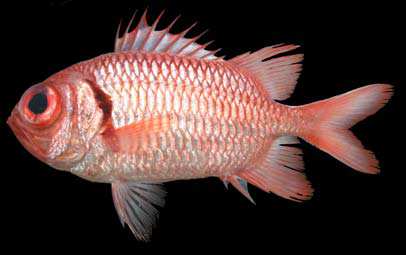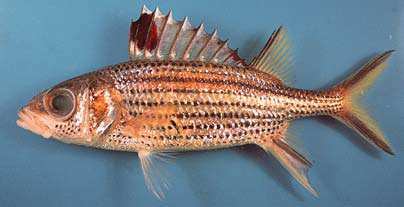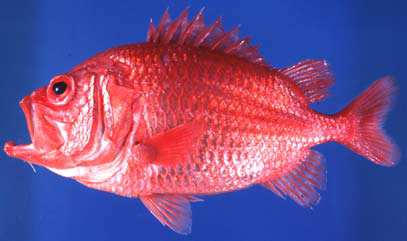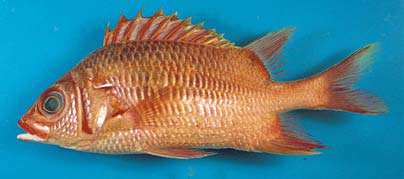HOLOCENTRIDAE
Soldierfishes
By Ukkrit Satapoomin
 Myripristis hexagona |
 Myripristis murdjan |
 Neoniphon sammara |
 Ostichthys japonicus |
 Sargocentron caudimaculatum |
 Sargocentron cornutum |
 Sargocentron melanospilos |
 Sargocentron rubrum |
 Sargocentron tiereoides |
|
Medium sized fishes attaining up to 45 cm, commonly 20-25 cm. Body ovate to moderately elongate, compressed, with large eyes. Edges of external bones of head serrate or with spines; mouth moderately large, terminal or with lower jaw projecting. Dorsal fin base long, with IX-XIII stout spines and 12-17 soft rays, deeply notched between spinous and soft portions or between last 2 dorsal fin spines; anal fin with IV spines, the third stoutest and often longest, and 7-16 soft rays; caudal fin forked with 18 or 19 principal caudal rays; pelvic fins with I spine and 7 soft rays. Large and very rough ctenoid scales, lateral line complete with 25-56 pored scales. Color: usually reddish or pink, scale centers of body often lighter or may be silvery white, thus forming longitudinal bands; black pigment may be present on opercular membrane or as markings in fins; fins may also have yellow or white markings. Similar families occurring in the area. None. The serrate bony edges and spines on head, in combination with the large eyes, the very long base on spinous portion of dorsal fin, the presence of IV anal spines and 7 pelvic soft rays, readily distinguishes the squirrelfishes and soldierfishes from other fish families occurring in the area. Remarks. Most are nocturnal, usually cryptic during the day in crevices or beneath ledges of reefs. Most species live in shallow water from shoreline to 100 m depth, rarely over 200 m. Soldierfishes feed mainly on large zooplankton whereas squirrelfishes feed on benthic invertebrates and small fishes. The preopercular spine of at least some species of Sargocentron is venomous. |

|
|